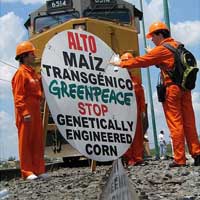Until relatively recently, Mexican authorities have staunchly resisted the introduction of GM corn into the country. Significant improvements in Mexico’s wheat and corn yields have been achieved in the past by long-term programs of selective breeding, such as that which was later dubbed the “Green Revolution“.
In 2009, however, Mexico’s Agriculture and Environment Secretariats approved a project financed by transnational seed firm Monsanto involving 30 hectares of experimental plots in Sonora, Sinaloa and Tamaulipas planted with transgenic corn. Mexico still does not yet permit the commercialization of genetically-modified corn, but Monsanto has indicated publicly that it hopes that current rules will be relaxed as early as 2011. According to Monsanto, the new seed could boost annual corn production in Mexico by between 6 and 7 million tons, roughly the amount lost each year to disease and pests.
The Monsanto project was been widely condemned by environmental groups. A widely-published article earlier this month by journalist Mica Rosenberg offered an overview of how transgenic (GM) corn is clearly on its way into Mexican mainstream agriculture:
The article is disappointingly superficial in many respects, but does provide a useful starting point for discussions about the relative merits of allowing (or not) commercial imports of transgenic corn seed into Mexico.
As we write in Geo-Mexico, Mexican farmers are well aware of the importance of maintaining genetic diversity:
Mexican farmers share concerns about the on-going loss of genetic diversity, especially in native crops. For example, if all corn farmers planted imported hybrid corn seeds, native diversity would quickly be lost. In Tlaxcala, where about 90% of the corn is grown on non-irrigated land and where two-thirds of farmers grow corn only for their own use, local varieties have been selectively bred by farmers not only for their yields but also because of their color, taste, resistance to pests and ability to withstand strong winds or short-term droughts. Such characteristics are not necessarily important to commercial seed producers.
Events in other countries often have unexpected consequences in Mexico. For example, the price of Mexico’s corn imports from the USA has increased sharply as a result of the high subsidies offered in that country for corn-based biofuel and bio-additives. The rising import price of corn led to an increase in the price of tortillas which adversely affected the poorest sectors of Mexican society.
Furthermore, as we wrote in an earlier post, the Mexican government has shown its support for a major project aimed at ensuring that the genetic diversity of corn is preserved for future generations:
Is the introduction of GM corn into Mexico a good idea? Proponents argue that it will lead to higher yields and reduce losses from pests and diseases. In their view, commercial planting of GM corn in Mexico is inevitable and will help Mexico “catch up” with Brazil and Argentina, where GM crops are already being grown. Opponents argue that it will inevitably reduce the genetic diversity of corn, meaning that corn will have less resilience in future to unexpected (and unpredicted) changes (climate, pests, soil conditions, etc). They also argue that GM corn will make corn growers even more dependent on commercial seed producers.
At least two studies since 2001 have already found transgenic DNA in fields of native Mexican corn. The first, published in Nature in 2001, reported findings from the state of Oaxaca. One oft-expressed fear is that Monsanto’s fierce protection of its GM corn will lead to the company seeking damages from local farmers who are found to have any GM corn mixed into the native corn growing in their fields, even if this is the result of accidental contamination from neighboring fields where GM crops are being legally cultivated.
- Greenpeace protests genetically modified corn in Mexico
- Fighting GMO contamination around the world (includes a section specific to Mexico)
Mexico’s agriculture is analyzed in chapter 15 of Geo-Mexico: the geography and dynamics of modern Mexico. and concepts of sustainability are explored in chapters 19 and 30. Buy your copy today, so you have this handy reference guide to all aspects of Mexico’s geography available whenever you need it.

Sorry, the comment form is closed at this time.